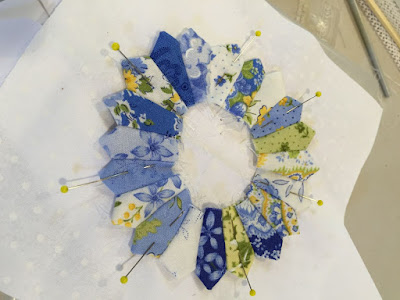Let's begin the new year on the front foot, with a post about a finish.
From the moment I set eyes on Jen Kingwell's My Small World quilt in the Spring 2015 edition of Quiltmania I was smitten.
A still, small (and frankly rather boring) inner voice cautioned that I had no time to cut out and sew together the thousands of tiny pieces needed to create this amazing combination of shapes and patterns.
Besides, I'd go crazy coping with the piles of tiny scraps all over my floor, sorted into the colour palette I needed to "paint" this imaginary world.
Not to mention my domestic machine quilting skills which I seriously doubted could do justice to such a quilt.
All of which was true.
However, once I realised My Small World would make the perfect quilt for a very special little person due to arrive in November, there was no stopping me.
I mined my scrap box like a maniac, digging for the brightest, happiest pieces I could find.
I fussy cut like a fiend so I could make my version into an "I Spy" quilt.
And I single-mindedly stitched together My Small World quilt top over six or seven weeks. Those fabric piles did drive me crazy, but they gave me the impetus I needed to get this stage finished.
It's a pattern that lends itself - almost invites itself - to personalising. So I created a sunny yellow, blue and white colour-washed sky and, instead of the stitcheries in the original design, I filled my sky (created with around 700 x 1 inch squares) with a fairytale castle, busy bees, bubbles and a big Dresden style sun.
All over the quilt I've included little objects that are fun to discover - a car, The Cat in the Hat, a zebra, a daisy, little children, a sailing boat...and so on.
While I thought about how I was going to approach the quilting of the buildings I worked an orange peel grid over the sky.
Then I decided to mentally break up the quilt into individual spaces and quilt each one separately. This approach meant that I could effectively avoid having to tackle machining over any any thick joins, but also gave the quilt a rich and varied texture matching the style of the original design.
My quilting was far from perfect, but again I feel it matches the quilt's naive style. That's my story, anyway, and I'm sticking to it!
I used Aurifil thread 50wt for both my piecing and quilting, and my batting was Soft and Bright from The Warm Company.
It was easy to add a multi-coloured binding using the method described here because the binding was applied in four separate strips and I could position the colour transitions exactly where I wanted them.

With this method the stitched mitred corners (almost) always turn out like this, which I love.
An "I Spy" quilt needs a label on the back with a list of objects to find.
Perhaps you can play the game yourself?
And finally this label, so that Princess 2 will always remember her grandma who took the time (around 4 months working 2 or 3 hours most days or evenings) to make her this gift of love.
And remained sane*
Please see these posts of mine if you're interested in more details, and tips, about the making of My Small World quilt.
* Some may disagree :-)









































